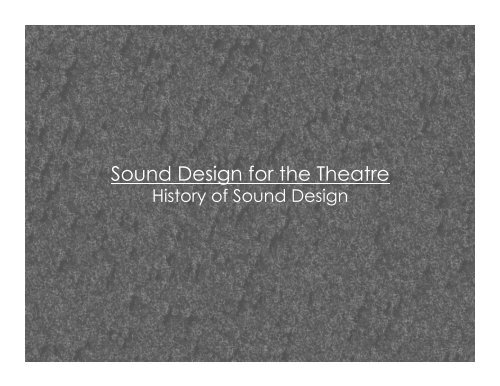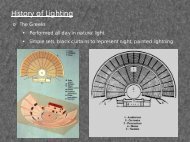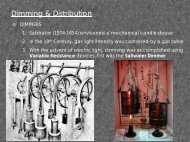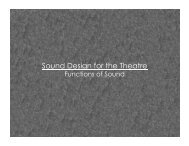You also want an ePaper? Increase the reach of your titles
YUMPU automatically turns print PDFs into web optimized ePapers that Google loves.
<strong>Sound</strong> <strong>Design</strong> for the Theatre<br />
<strong>History</strong> <strong>of</strong> <strong>Sound</strong> <strong>Design</strong>
<strong>History</strong> <strong>of</strong> <strong>Sound</strong><br />
o In the beginning…<br />
1. Primitive rituals (burials, harvest festivals) were accompanied by<br />
drums or other simple instruments
<strong>History</strong> <strong>of</strong> <strong>Sound</strong><br />
o In the beginning…<br />
1. Primitive rituals (burials, harvest festivals) were accompanied by<br />
drums or other simple instruments<br />
2. Early theatre in China and India (4000 – 2000 BCE) used little scenery<br />
but utilized music and sound for accompaniment and underscore
<strong>History</strong> <strong>of</strong> <strong>Sound</strong><br />
o The Greeks (c. 500 – 146 BCE)<br />
1. Placed emphasis on actor’s voice in speech, recitative and song<br />
2. Music was integral, accompanied choral odes<br />
3. Amphitheatre architecture provided excellent acoustics<br />
4. Some researchers think masks <strong>of</strong>fered amplification, though this is<br />
mostly disproven because <strong>of</strong> amphitheatre acoustics<br />
Theatre at Epidaurus
<strong>History</strong> <strong>of</strong> <strong>Sound</strong><br />
o Italian and English Renaissance (c. 1300 – 1620 CE)<br />
1. Built upon the musical conventions <strong>of</strong> Medieval drama<br />
2. Commedia dell’arte used music before and after plays as well as to<br />
support the action. Also used sound effects such as the slapstick to<br />
heighten physical comedy.<br />
3. Elizabethan theatre created atmosphere with music and used it for<br />
scene transitions and pantomimed dumb shows during the play.<br />
Scripts called for practical <strong>of</strong>fstage sound effects such as bells,<br />
chimes, thunder and gunshots.
<strong>History</strong> <strong>of</strong> <strong>Sound</strong><br />
o Realism (late 1800s) and Expressionism (early 1900s)<br />
1. Realism, starting with Moscow Art Theatre’s 1898 production <strong>of</strong><br />
The Seagull, attempted to present the play as a “slice <strong>of</strong> life”,<br />
required a large number <strong>of</strong> practical sound effects
<strong>History</strong> <strong>of</strong> <strong>Sound</strong><br />
o Realism (late 1800s) and Expressionism (early 1900s)<br />
2. The first production <strong>of</strong> Our Town in 1938 used no recorded effects,<br />
sound effects were created <strong>of</strong>fstage by actors and stagehands
<strong>History</strong> <strong>of</strong> <strong>Sound</strong><br />
o Research into <strong>Sound</strong><br />
1. Leonardo da Vinci (1452-1519) : sketched design for a tube speaker<br />
2. Joseph Louis Gay-Lussac (1778-1850) : determined velocity <strong>of</strong> sound<br />
at sea level (1130 ft/s)<br />
3. Felix Savart (1791-1841) : measured frequencies <strong>of</strong> musical pitches,<br />
invented “Savart’s Wheel” that produced sound at specific<br />
frequencies with a rotating wheel<br />
4. Hermann von Helmholtz (1821-1894) : laws <strong>of</strong> harmonics, resonance
<strong>History</strong> <strong>of</strong> <strong>Sound</strong><br />
o PHONAUTOGRAPH (1857)<br />
1. Invented by Leon Scott (1817-1879)<br />
2. Visibly recorded sound vibrations on blackened paper
<strong>History</strong> <strong>of</strong> <strong>Sound</strong><br />
o PHONOGRAPH (1877)<br />
1. Invented by Thomas Edison (1847-1931)<br />
2. Fruit <strong>of</strong> experiments to develop a telephone signal repeater<br />
3. Edison foresaw many uses such as the answering machine, dictation<br />
4. Built with tinfoil cylinder as recording medium
<strong>History</strong> <strong>of</strong> <strong>Sound</strong><br />
o PHONOGRAPH (1877)<br />
5. A.G. Bell patented the Gramophone using a wax cylinder (1881)<br />
6. Emil Berliner developed a flat disc for recording (1887)<br />
7. By 1900 the standard was a shellac disc spinning at 78 rpm,<br />
allowed mass production <strong>of</strong> discs
<strong>History</strong> <strong>of</strong> <strong>Sound</strong><br />
o PHONOGRAPH (1877)<br />
8. Western Electric developed the electric pickup (1918)<br />
9. Sawyer created the crystal (piezoelectric) pickup (1931)<br />
10. DC motors replaced by rim-drive system, increasing quality (1938)<br />
11. Shellac replaced with vinyl plastic, allowed smaller groove and<br />
higher speeds, 45 and 33 1/3 rpm (1944)<br />
12. Stereo sound developed (1957)
<strong>History</strong> <strong>of</strong> <strong>Sound</strong><br />
o MAGNETIC RECORDING<br />
1. Oberlin Smith suggested the wire recorder (1888)<br />
Valdemar Poulsen made first working model in 1898
<strong>History</strong> <strong>of</strong> <strong>Sound</strong><br />
o MAGNETIC RECORDING<br />
2. First audio tape (paper/FeO) created by Fritz Pfleumer (1928)<br />
3. Different mediums experimented with including a tungsten/steel strip<br />
so dangerous it had to be housed separately from the operator,<br />
a reel <strong>of</strong> tape for a half-hour program weighed 25 kg (55 lbs)
<strong>History</strong> <strong>of</strong> <strong>Sound</strong><br />
o MAGNETIC RECORDING<br />
4. Polyester replaced paper as substrate (1957), found wide use in the<br />
music industry, easy to edit<br />
5. Phillips introduced the 8-track cassette tape (1963)<br />
gained popularity in car stereos
<strong>History</strong> <strong>of</strong> <strong>Sound</strong><br />
o MAGNETIC RECORDING<br />
4. Polyester replaced paper as substrate (1957), found wide use in the<br />
music industry, easy to edit<br />
5. Phillips introduced the 8-track cassette tape (1963)<br />
gained popularity in car stereos<br />
6. Sony released the Walkman (1979)<br />
used stereo cassette tape, was portable and easy to record on
<strong>History</strong> <strong>of</strong> <strong>Sound</strong><br />
o DIGITAL AUDIO<br />
1. Charles Babbage (1791-1871) theorized analytical engine (1842),<br />
his Difference Engine was the predecessor to modern computers
<strong>History</strong> <strong>of</strong> <strong>Sound</strong><br />
o DIGITAL AUDIO<br />
2. Harry Nyquist (1889-1976) wrote about sampling theory (1928)<br />
sampling is a method <strong>of</strong> turning analog signal into digital information<br />
3. NHK demonstrated digital audio tape (DAT) recorder (1967)<br />
4. Phillips introduced prototype compact disc (CD) player (1979)<br />
5. Phillips and Sony developed CD standard for mass production (1980)<br />
6. Semiconductor laser allows for smaller CD systems (1982)<br />
7. First CD marketed in the US (1983)
<strong>History</strong> <strong>of</strong> <strong>Sound</strong><br />
o <strong>Sound</strong> in the Cinema<br />
1. The first ‘talkie’ was The Jazz Singer which used a process called<br />
Vitaphone where the projector had a mechanical interlock to drive<br />
an attached phonograph playing sound in sync to the film.
<strong>History</strong> <strong>of</strong> <strong>Sound</strong><br />
o <strong>Sound</strong> in the Cinema<br />
2. Optical recording on film was introduced in the 1930s, the edge <strong>of</strong><br />
the film had either variable density or width, optical sensor translated<br />
the amount passing through into sound.
<strong>History</strong> <strong>of</strong> <strong>Sound</strong><br />
o <strong>Sound</strong> in the Cinema<br />
3. In the 1950s magnetic tape was incorporated onto the film
<strong>History</strong> <strong>of</strong> <strong>Sound</strong><br />
o <strong>Sound</strong> in the Cinema<br />
4. With the release <strong>of</strong> Jurassic Park (1993) Digital Theatre Systems (DTS)<br />
format was introduced, contained a time code track that synced<br />
with a separate audio CD
<strong>History</strong> <strong>of</strong> <strong>Sound</strong><br />
o <strong>Sound</strong> in the Theatre<br />
1. Prerecorded sound effects become available on shellac records in<br />
the 1930’s, Bertolt Brecht uses them in many <strong>of</strong> his productions.<br />
Cues were played back on double turntables, <strong>of</strong>ten a production<br />
had specially pressed records with cues on them
<strong>History</strong> <strong>of</strong> <strong>Sound</strong><br />
o <strong>Sound</strong> in the Theatre<br />
2. By the 1950’s tape recorders came into widespread use<br />
With no sound designer or audio crew, effects were found by the<br />
stage manager and run by stage electricians<br />
Directors with Hollywood backgrounds tried to emulate the sound <strong>of</strong><br />
the cinema, but tapes were <strong>of</strong>ten <strong>of</strong> poor quality and unreliable so<br />
many cues were cut by the time a show reached Broadway
<strong>History</strong> <strong>of</strong> <strong>Sound</strong><br />
o <strong>Sound</strong> in the Theatre<br />
3. Due to complicated, unreliable technology, sound design was <strong>of</strong>ten<br />
left out or as a second thought<br />
Dan Dugan was the first person to be called a sound designer at<br />
ACT in San Francisco during the 1968-69 season; the Broadway<br />
production <strong>of</strong> Hair (1968) credited “<strong>Sound</strong> by Bob Kernan”; On Jesus<br />
Christ Superstar (1971) Abe Jacob was billed as “sound designer”
<strong>History</strong> <strong>of</strong> <strong>Sound</strong><br />
o <strong>Sound</strong> in the Theatre<br />
4. In the 1990’s digital playback and recording was introduced to the<br />
theatre with CDs, MiniDiscs, DATs, samplers and DAWs<br />
With the continuing drop in prices and increase in quality <strong>of</strong> digital<br />
audio equipment, the sound designer’s flexibility and control has<br />
vastly improved and with this greater consideration and impact in<br />
productions.






